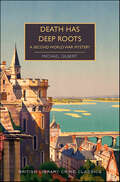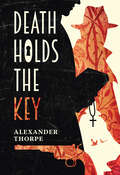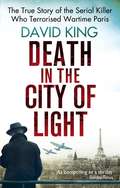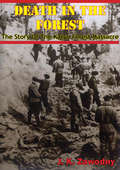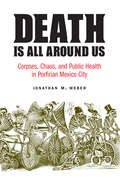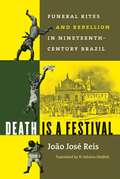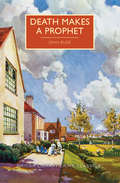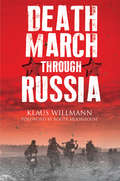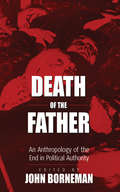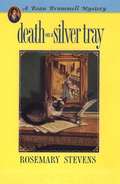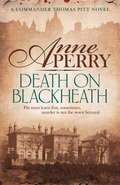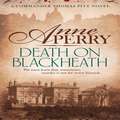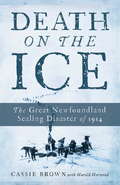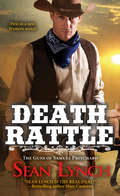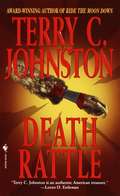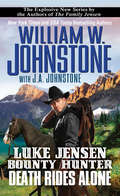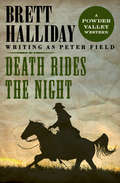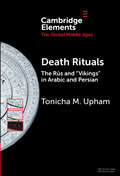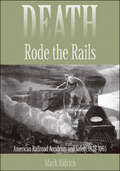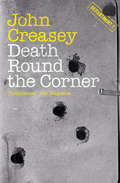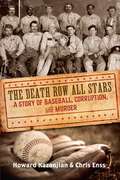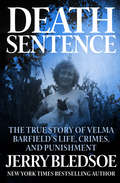- Table View
- List View
Death Has Deep Roots: A Second World War Mystery (British Library Crime Classics #5)
by Michael GilbertMystery crime fiction written in the Golden Age of MurderAn eager London crowd awaits the trial of Victoria Lamartine, hotel worker, ex-French Resistance fighter, and the only logical suspect for the murder of her supposed lover, Major Eric Thoseby. Lamartine—who once escaped from the clutches of the Gestapo—is set to meet her end at the gallows.One final opportunity remains: the defendant calls on solicitor Nap Rumbold to replace the defence counsel,and grants an eight-day reprieve from the proceedings. Without any time to spare, Rumbold boards a ferry across the Channel, tracing the roots of the brutal murder back into the war-torn past.Expertly combining authentic courtroom drama at the Old Bailey with a perilous quest for evidence across France, Death Has Deep Roots is an unorthodox marvel of the mystery genre.
Death Holds the Key
by Alexander ThorpeWhen loathed landholder Fred O' Donnell is found dead in a locked room with a bullet in his chest, rookie Detective Hartley must seek help from a mysterious wanderer to solve the case. And it' s one where everyone, including his family, has a motive and a secret to keep.Featuring the mendicant monk from Thorpe' s previous novel, Death Leaves the Station, readers will be drawn into the world of small-town Western Australia in the late 1920s, delighting in the characters as they navigate the strained sensibilities and dark secrets of the past. Full of twists and turns, this seemingly impossible murder mystery is cosy crime writing at its finest.
Death In The City Of Light: The True Story of the Serial Killer Who Terrorised Wartime Paris
by David KingTHE MOST AMAZING TRUE STORY SINCE AGENT ZIGZAGOCCUPIED PARIS, 1944.A swastika crowns the Eiffel Tower.Nazis march through the streets.And in the dark heart of the city, a madman is at work . . .At a chic Right Bank address, a horrific pile of dismembered bodies is discovered. The property's owner, well-to-do Dr Petiot, immediately becomes the prime suspect, but he has vanished without a trace. As the police delve into the doctor's past, a disturbing history of violence and corruption is uncovered. It seems like a cut-and-dried case, but the investigation soon takes a surprising turn. Is Petiot a sadistic serial killer or a hero of the Resistance? Who are his victims?In this fascinating true account of a case that gripped wartime Paris, David King draws extensively on new sources to paint a chilling portrait of a murderer whose crimes devastated a city already in the grip of evil.
Death In The Forest; The Story Of The Katyn Forest Massacre: The Story Of The Katyn Forest Massacre
by J. K. ZawodnyMORE THAN 15,000 Polish soldiers, among them 800 Doctors of Medicine, were murdered in one operation. Originally they had been taken into captivity by the Soviet Army in 1939. There was a possibility, however, that the prisoners, while still alive, had been taken from Soviet custody by German forces in 1941.Some of the bodies were found in German-held territory. The ropes with which their hands were tied were Soviet-made, but the bullets with which the men were killed were of German origin.The Soviet and German governments accused each other of the massacre. To obtain or remove the evidence, the intelligence services of several nations carried on a merciless secret contest in the Katyn Forest, Poland, Germany, Italy, England, and the United States. Men disappeared; so did files, including one from the United States Military Intelligence Office. In the process a key witness was found hanged, diplomatic and military careers were destroyed in the United States, personnel of the International Military Tribunal at Nuremberg lied by omission, and so did some of the greatest Allied leaders of the Second World War.This book attempts to reconstruct, in detail, the fate of the prisoners and to provide the answers to these questions:(1) Who killed these men?(2) How were they killed?(3) Why were they killed?
Death Is All around Us: Corpses, Chaos, and Public Health in Porfirian Mexico City (The Mexican Experience)
by Jonathan M. WeberLate nineteenth-century Mexico was a country rife with health problems. In 1876, one out of every nineteen people died prematurely in Mexico City, a staggeringly high rate when compared to other major Western world capitals at the time, which saw more modest premature death rates of one out of fifty-two (London), one out of forty-four (Paris), and one out of thirty-five (Madrid). It is not an exaggeration to maintain that each day dozens of bodies could be found scattered throughout the streets of Mexico City, making the capital city one of the most unsanitary places in the Western Hemisphere. In light of such startling scenes, in Death Is All around Us Jonathan M. Weber examines how Mexican state officials, including President Porfirio Díaz, tried to resolve the public health dilemmas facing the city. By reducing the high mortality rate, state officials believed that Mexico City would be seen as a more modern and viable capital in North America. To this end the government used new forms of technology and scientific knowledge to deal with the thousands of unidentified and unburied corpses found in hospital morgues and cemeteries and on the streets. Tackling the central question of how the government used the latest technological and scientific advancements to persuade citizens and foreigners alike that the capital city—and thus Mexico as a whole—was capable of resolving the hygienic issues plaguing the city, Weber explores how the state’s attempts to exert control over procedures of death and burial became a powerful weapon for controlling the behavior of its citizens.
Death Is a Festival
by João José ReisThis award-winning social history of death and funeral rites during the early decades of Brazil's independence from Portugal focuses on the Cemiterada movement in Salvador, capital of the province of Bahia. The book opens with a lively account of the popular riot that ensued when, in 1836, the government condemned the traditional burial of bodies inside Catholic church buildings and granted a private company a monopoly over burials. This episode is used by Reis to examine the customs of death and burial in Bahian society, explore the economic and religious conflicts behind the move for funerary reforms and the maintenance of traditional rituals of dying, and understand how people dealt with new concerns sparked by modernization and science. Viewing culture within its social context, he illuminates the commonalities and differences that shaped death and its rituals for rich and poor, men and women, slaves and masters, adults and children, foreigners and Brazilians.This translation makes the book, originally published in Brazil in 1993, available in English for the first time.
Death Makes a Prophet (British Library Crime Classics #0)
by Martin Edwards John BudeWITH AN INTRODUCTION BY MARTIN EDWARDS 'Small hostilities were growing; vague jealousies were gaining strength; and far off, wasn't there a nebulous hint of approaching tragedy in the air?' Welworth Garden City in the 1940s is a forward-thinking town where free spirits find a home-vegetarians, socialists, and an array of exotic religious groups. Chief among these are the Children of Osiris, led by the eccentric High Prophet, Eustace K. Mildmann. The cult is a seething hotbed of petty resentment, jealousy and dark secrets - which eventually lead to murder. The stage is set for one of Inspector Meredith's most bizarre and exacting cases. This witty crime novel by a writer on top form is a neglected classic of British crime fiction.
Death March Through Russia: The Memoir Of Lothar Herrmann
by Klaus WillmannThis World War II memoir by a Nazi soldier details his unimaginable experience as a German prisoner-of-war in the Soviet Union. Lothar Hermann grew up in Bavaria, going through the RAD (Nazi Labor Service) before being conscripted into a Wehrmacht Mountain Division (the Gebirgsdivision) in 1940. He participated in Germany&’s advance through southern Ukraine in 1941 and, in 1944, was arrested in Romania while retreating to Germany. The Romanians passed him onto the Soviets, who placed him in a forced labor camp, where he watched two-thirds of prisoners around him die. In 1949, Herrmann was finally released to Germany and returned to Bavaria. Three million German troops were taken prisoner by the Red Army and around two-thirds of them survived to return to Germany in 1949 like Hermann, but their stories are little known. Klaus Willmann draws on interviews he conducted with Herrmann, to recount these astonishing recollections in the first-person. Depicting the challenges of growing up in Nazi Bavaria to becoming a Soviet prisoner-of-war, this is a gripping and enlightening account from a necessary but rarely explored perspective.
Death March Through Russia: The Memoir Of Lothar Herrmann
by Klaus WillmannThis World War II memoir by a Nazi soldier details his unimaginable experience as a German prisoner-of-war in the Soviet Union. Lothar Hermann grew up in Bavaria, going through the RAD (Nazi Labor Service) before being conscripted into a Wehrmacht Mountain Division (the Gebirgsdivision) in 1940. He participated in Germany&’s advance through southern Ukraine in 1941 and, in 1944, was arrested in Romania while retreating to Germany. The Romanians passed him onto the Soviets, who placed him in a forced labor camp, where he watched two-thirds of prisoners around him die. In 1949, Herrmann was finally released to Germany and returned to Bavaria. Three million German troops were taken prisoner by the Red Army and around two-thirds of them survived to return to Germany in 1949 like Hermann, but their stories are little known. Klaus Willmann draws on interviews he conducted with Herrmann, to recount these astonishing recollections in the first-person. Depicting the challenges of growing up in Nazi Bavaria to becoming a Soviet prisoner-of-war, this is a gripping and enlightening account from a necessary but rarely explored perspective.
Death Of The Father
by John BornemanThe death of authority figures like fathers or leaders can be experienced as either liberation or loss. In the twentieth century, the authority of the father and of the leader became closely intertwined; constraints and affective attachments intensified in ways that had major effects on the organization of regimes of authority. This comparative volume examines the resulting crisis in symbolic identification, the national traumas that had crystallized around four state political forms: Fascist Italy, Nazi Germany, Imperial Japan, and East European Communism. The defeat of Imperial and Fascist regimes in 1945 and the implosion of Communist regimes in 1989 were critical moments of rupture, of "death of the father." What was the experience of their ends, and what is the reconstruction of those ends in memory? This volume represents is the beginning of a comparative social anthropology of caesurae: the end of traumatic political regimes, of their symbolic forms, political consequences, and probable futures.
Death On A Silver Tray
by Rosemary StevensIn the days of Regency England, Beau Brummell stood as the uncrowned king of genteel society. The quintessential style-maker, trend-setter, and fashion-forger, Brummell was the last person one would expect to find in the middle of a murder mystery. But then, Beau Brummell was never one to do what was expected. When the Duchess of York begs for his help, Beau Brummell wouldn't think of refusing. The Countess of Wrayburn has been poisoned, and her paid companion is the prime suspect. Unfortunately, the Duchess is the one who arranged the young woman's employment with the late Countless, and the scandal could ruin the Duchess' good name.
Death On Blackheath: Secrecy, betrayal and murder on the streets of Victorian London (Thomas Pitt Mystery #29)
by Anne PerryPitt must learn that, sometimes, murder is not the worst betrayal... Death on Blackheath is a masterful tale of the secrecy and lies hiding just beneath the glittering surface of wealthy Victorian society, featuring Anne Perry's much-loved detective Thomas Pitt. Perfect for fans of C. J. Sansom and Sarah Perry.'There is a freshness about [Perry's] writing which makes it truly exceptional and I was gripped until the final page. Death on Blackheath was one of the best books I've read this year and I cannot recommend it highly enough' - Eurocrime Greenwich, 1897. A macabre scene is discovered outside a house on Shooters Hill. There has been a vicious fight, and amid the bloodstains are locks of long auburn hair. Thomas Pitt, head of Special Branch, is called: this is the home of Dudley Kynaston, a minister with access to some of the government's most dangerous secrets, and any inquiry must be handled with utmost discretion. An auburn-haired maid has disappeared from Kynaston's household, but no major crime appears to have taken place. Then a disfigured body is found in the gravel pits nearby. Could this be Kynaston's missing servant? As Pitt begins to investigate, he finds small inconsistencies in Kynaston's story. Are these harmless omissions, or could they lead to something more serious, something that could threaten not just Kynaston's own family but also his Queen and country? What readers are saying about Death on Blackheath: 'If you're looking for intelligent historical crime fiction with solid characterisation and a good sense of the period, Perry can always be relied upon''Death on Blackheath combines her usual lush descriptions that so completely transport the reader into the time period with pacing so remarkably quick, I believe this may be one of Perry's best literary efforts to date''[Anne Perry's] books are always gripping and beautifully written'
Death On Blackheath: Secrecy, betrayal and murder on the streets of Victorian London (Thomas Pitt Mystery #29)
by Anne PerryGreenwich,1897. A macabre scene is discovered outside a house on Shooters Hill. There has been a vicious fight, and amid the bloodstains are locks of long auburn hair. Thomas Pitt, head of Special Branch, is called: this is the home of Dudley Kynaston, a minister with access to some of the government's most dangerous secrets, and any inquiry must be handled with utmost discretion.Although an auburn-haired maid is missing from Kynaston's household, with no evidence there is little Pitt can do. Until a corpse, mutilated beyond recognition, is discovered a few weeks later. As Pitt begins to investigate, he finds small inconsistencies in Kynaston's story. Are these harmless omissions, or could they lead to something more serious, something that could threaten not just Kynaston's own family but also his Queen and country?(P)2013 Headline Digital
Death On The Ice
by Cassie BrownEach year, for generations, poor, ill-clad Newfoundland fisherman sailed out 'to the ice' to hunt seals in the hope of a few penniew in wages from the prosperous merchants of St. John's. The year 1914 witnessed the worst in the long line of tragedies that were part of their harsh way of life.For two long, freezing days and nights a party of seal hunters--one hundred thirty-two men--were left stranded on an icefield floating in the North Atlantic in winter. They were thinly dressed, with almost no food, and with no hope of shelter on the ice against the snow or the constant, bitter winds. To survive they had to keep moving, always moving. Those who lay down to rest died.Heroes emerged--one man froze his lips badly, biting off the icicles that were blinding his comrades. Other men froze in their tracks, or went mad with pain and walked off the edge of the icefield. All the while, ships steamed about nearby, unnoticing. And by the time help arrived, two thirds of the men were dead.This is an incredible story of bungling and greed, of suffering and heroism. The disaster is carefully traced, step by step. With the aid of compelling, contemporary photographs the book paints an unforgettable portrait of the bloody trade of seal hunting among the icefields when ships--and men--were expendable.From the Trade Paperback edition.
Death Rattle (The Guns of Samuel Pritchard #1)
by Sean LynchFrom acclaimed author Sean Lynch comes the epic saga of Samuel Pritchard, a young man coming of age in the Civil War, riding tall with the Texas Rangers, and becoming one of the greatest gunfighters of his time . . . THE LEGEND BEGINS In 1863, a teenaged boy fled his home in Atherton, Missouri, to escape the power-hungry men who murdered his father and stole his family’s land. He joined the Confederacy under an assumed name and led guerilla raids in the Civil War. Then came a decade as a Texas Ranger. Now, after ten blood-soaked years, he is finally coming home. Finally using his real name. And finally getting revenge against the cold-hearted devils who destroyed his family and his life . . . This is the story of Samuel Pritchard. Now a small town sheriff with a long history of violence, a deep sense of honor, and wild streak of justice as dangerous as the guns that made him famous . . . “A riveting thriller that bristles with hard-boiled authenticity.” —bestselling author Mark Greaney on Thy Partner’s Wife “Sean Lynch spins a tale that is fast, fun and realistic.” —Bestselling author James O. Born on Like Hell
Death Rattle: A Novel (Titus Bass #8)
by Terry C. JohnstonWith the end of the beaver trade at hand, free trappers like Titus Bass must somehow make their way on a changing frontier. Drawn by the promise of adventure and wealth, Bass joins an expedition to Spanish California, where the ranchos have horses and mules in abundance. Their plan is to steal the livestock and drive it back east across the great Mojave Desert to sell to fur traders for top dollar. But pursuit by formidable Mexican soldiers and an attack by fierce Digger Indians take their toll on Bass and his fellow raiders.Arriving back in the Rockies, the mountain man discovers that even the famous Jim Bridger has abandoned trapping and settled down to trade with overland immigrants plying the Oregon Trail. Wondering where his own trail will lead him, Bass journeys south for a reunion with an old friend in Taos-only to be caught up in the "Taos Rebellion." And in its tragic aftermath, Titus finds himself once again an outsider in a world he no longer recognizes.From the Paperback edition.
Death Ride of the Panzers: German Armor and the Retreat in the West, 1944-45
by Dennis OliverDeath Ride of the Panzers is a unique guide to the Nazi tanks, vehicles, and crews of World War II. It features never-before-seen photographs from the US National Archives and the author's personal collection, annotated artist renderings, and detailed explanations and historical context for each collection of images. Readers will also be able to trace the combat histories of these subjects through orders of battle, maps and organizational diagrams, vehicle allocation charts, and unit biographies. The forensic approach for which Dennis Oliver is known creates a broad, comprehensive record of German soldiers and hardware from early 1944 to the end of the conflict in 1945. Death Ride of the Panzers provides the context and chronology necessary for the general reader and the primary sources and hardware specifics that appeal to the expert, making this book perfect for the readers with historical interest, modelers, and WWII alike.
Death Rides Alone (Luke Jensen Bounty Hunter #5)
by William W. Johnstone J.A. JohnstoneA cowboy on the right side of justice finds himself on the wrong side of a barrel—from the bestselling Western authors of the Sidewinders series. Mountain Man Smoke Jensen&’s long-lost brother Luke Jensen is a dead shot scarred by war—the perfect formula for a bounty hunter. And he&’s cunning, and fierce enough to bring down the deadliest outlaws of his day . . .Law of the Gun Luke Jensen has earned this bounty, hunting down the violent man charged with murdering a preacher&’s daughter. The outlaw Judd Tyler confesses to many crimes, but not the girl&’s murder. And he tells Luke they won&’t reach the town of White Fork alive because a corrupt sheriff does the bidding of a cattle baron, and that man&’s son is the true killer. Sure enough, halfway to White Fork, Luke and his prisoner are battling for their lives, and when they finally reach town, they&’re greeted by a storm of bullets, betrayal, and blood. With a band of innocent travelers caught up in the melee, Luke is outgunned, surrounded, and sure of one thing: his only job now is survival—by the measured, efficient, righteous killing of as many men as he can . . . Praise for the novels of William W. Johnstone &“[A] rousing, two-fisted saga of the growing American frontier.&”—Publishers Weekly on Eyes of Eagles &“There&’s plenty of gunplay and fast-paced action.&”—Curled Up with a Good Book on Dead Before Sundown
Death Rides the Night (The Powder Valley Westerns #8)
by Brett HallidayIn a formerly peaceful western valley, a sheriff and his friends battle a corrupt land speculator Pat, Sam, and Ezra came to Powder Valley together, to tame the West and find a place to settle down. Soon, Pat is the sheriff, and Sam is married, but big, powerful Ezra, with his craggy face and missing eye, remains a loner. This state of affairs usually doesn't get Ezra down, but tonight the big man is too gloomy to eat peach pie. When Ezra can't eat peach pie, something is wrong--and Pat is certain it has to do with Eustis Harlow. After six months in Powder Valley, Harlow has established himself as the most powerful rancher in the area. Before he came, the locals were content with what they had. Now, half of them are in his debt, and the others have been consumed by greed. With the sheriff and his friends gearing up to quash Harlow's dominance, the rancher sends for an army's worth of gunmen. Powder Valley is about to explode.
Death Rituals: The Rūs and 'Vikings' in Arabic and Persian (Elements in the Global Middle Ages)
by Tonicha M. UphamIn the study of the early medieval Rūs and the Viking diaspora, Arabic geographical writings on the practice of funerary sacrifice loom large. Against growing uses of this body of source material as evidence on ritual, the treatment of women, and the global connections of the Rūs, critical issues in the use of and access to this source material necessitate a fresh analysis. This Element reevaluates geographical writings on Rūs death and sacrificial rituals, redirecting focus towards the textual transmission of ideas in both Arabic and Persian to offer a critical guide to geographical knowledge dissemination on Rūs funerary practices.
Death Rode the Rails: American Railroad Accidents and Safety, 1828–1965
by Mark AldrichFor most of the 19th and much of the 20th centuries, railroads dominated American transportation. They transformed life and captured the imagination. Yet by 1907 railroads had also become the largest cause of violent death in the country, that year claiming the lives of nearly twelve thousand passengers, workers, and others. In Death Rode the Rails Mark Aldrich explores the evolution of railroad safety in the United States by examining a variety of incidents: spectacular train wrecks, smaller accidents in shops and yards that devastated the lives of workers and their families, and the deaths of thousands of women and children killed while walking on or crossing the street-grade tracks. The evolution of railroad safety, Aldrich argues, involved the interplay of market forces, science and technology, and legal and public pressures. He considers the railroad as a system in its entirety: operational realities, technical constraints, economic history, internal politics, and labor management. Aldrich shows that economics initially encouraged American carriers to build and operate cheap and dangerous lines. Only over time did the trade-off between safety and output—shaped by labor markets and public policy—motivate carriers to develop technological improvements that enhanced both productivity and safety.A fascinating account of one of America's most important industries and its dangers, Death Rode the Rails will appeal to scholars of economics and the history of transportation, technology, labor, regulation, safety, and business, as well as to railroad enthusiasts.
Death Round the Corner (Department Z #4)
by John CreaseyA terrifying international plot threatens the agents of Britain’s Department Z in this tale of suspense from an Edgar Award–winning author.Leopold Gorman studies the World Economic Conference with interest—and then picks five rich and powerful men to bring his plan to fruition. If any one of them shows reluctance to fall in with his scheme, he’ll be dead within the hour . . .Gordon Craigie, chief of British intelligence, is the only thing standing between Gorman and success. So Gorman turns his attentions to Craigie’s greatest asset: the men of Department Z.As Craigie attempts to undermine Gorman’s plot, Gorman decides which agent should be next to “disappear.” Can Craigie and his men outwit this master criminal before it’s too late?
Death Row All Stars: A Story of Baseball, Corruption, and Murder
by Chris Enss Howard KazanjianIt was the golden age of baseball, and all over the country teams gathered on town fields in front of throngs of fans to compete for local glory. In Rawlins, Wyoming, residents lined up for tickets to see slugger Joseph Seng and the rest of the Wyoming Penitentiary Death Row All Stars as they took on all comers in baseball games with considerably more at stake. Teams came from Reno, Nevada; Klamath Falls, Oregon; Bodie, California; and throughout the west to take on the murderers who made up the line-up. This is a fun and wildly dramatic and suspenseful look at the game of baseball and at the thrilling events that unfolded at a prison in the wide-open Wyoming frontier in pursuit of wins on the diamond.
Death Scenes
by Sean Tejaratchi Dunn KatherineThe strange and gruesome crime-scene snapshot collection of LAPD detective Jack Huddleston spans Southern California in its noir heyday. Death Scenes is the noted forerunner of several copycat titles.
Death Sentence: The True Story of Velma Barfield's Life, Crimes, and Punishment
by Jerry BledsoeIn this &“true story that reads like a novel,&” the #1 New York Times–bestselling author reveals the facts behind a notorious Southern murder case (Library Journal). When North Carolina farmer Stuart Taylor died after a sudden illness, his forty-six-year-old fiancée, Velma Barfield, was overcome with grief. Taylor&’s family grieved with her—until the autopsy revealed traces of arsenic poisoning. Turned over to the authorities by her own son, Velma stunned her family with more revelations. This wasn&’t the first time she had committed cold-blooded murder, and she would eventually be tried by the &“world&’s deadliest prosecutor&” and sentenced to death. This book probes Velma&’s stark descent into madness, her prescription drug addiction, and her effort to turn her life around through Christianity. From her harrowing childhood to the crimes that incited a national debate over the death penalty, to the final moments of her execution, Velma Barfield&’s life of crime and punishment, revenge and redemption, this is crime reporting at its most gripping and profound. &“A painfully intimate, moving story about the life and death of the only woman executed in the U.S. between 1962–1998 . . . With graceful writing and thorough reporting, it makes the reader look hard at something dark and sad in the human soul . . . Breathes new life into the true crime genre.&” —The News & Observer &“Undertakes to answer the questions about the justice system and the motives that drive women to kill.&” —The Washington Post Book World &“An extraordinary piece of writing . . . The most chilling description of a legal execution that we are ever likely to get.&” —Citizen-Times &“Taut and engrossing on the nature of justice and the death penalty as well as on guilt and responsibility.&” —Booklist
